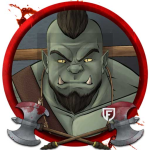Beoric
8, 8, I forget what is for
An addendum to the above: all of this applies to running NPCs as well. I can keep several NPCs in my head at a time, with complete personalities; make decisions in character for them all; speak for them in character (although usually not with funny voices), even run conversations between them; and keep track of what they are doing and what they plan on doing. I reveal character through what they say and what they do. All of that is lost on my hyperphantasic player if I don't find a way to engage her senses.
An example. Druid NPC has a crush on Ranger NPC. Player is running fighter PC. Bard NPC enters the group. Bard and ranger start to connect; druid gets jealous. Bard and ranger start spending a lot of time together, always want to take the same watch, do other things as a unit. Druid acts surly, takes verbal shots at the bard, starts refusing to work well with the bard during combat, preferentially heals and buffs other characters, especially the ranger. Player does not notice the NPCs spending time together, but does notice the shenanigans in combat; player has no idea what it going on, doesn't even know how to approach the situation, other than to tell the druid to smarten up. Player is utterly lost without some sort of sensory cue, and subtle clues, like NPCs looking at each other without describing what the look is, are not sufficient.
And I don't want to give away the game, because the player's character is supposed to be a leader of men, and identifying and addressing this conflict is part of that. The bard and ranger are being coy and trying to hide their attraction, and the player shouldn't get to rely on an assumption that she will correctly read their microexpressions. But short of describing the lovers as mooning over each other, or the druid as looking jealous (although I did describe him as looking angry at the bard), or replicating the tone of voice of the NPCs when I speak as them, it is difficult to describe the sensory cues of a social environment. Like, how do you describe body language, without actually translating it? It apparently wasn't sufficient to always describe the lovers as standing next to each other (or placing their tokens near each other on the map), or that the druid couldn't even look at the bard.
An example. Druid NPC has a crush on Ranger NPC. Player is running fighter PC. Bard NPC enters the group. Bard and ranger start to connect; druid gets jealous. Bard and ranger start spending a lot of time together, always want to take the same watch, do other things as a unit. Druid acts surly, takes verbal shots at the bard, starts refusing to work well with the bard during combat, preferentially heals and buffs other characters, especially the ranger. Player does not notice the NPCs spending time together, but does notice the shenanigans in combat; player has no idea what it going on, doesn't even know how to approach the situation, other than to tell the druid to smarten up. Player is utterly lost without some sort of sensory cue, and subtle clues, like NPCs looking at each other without describing what the look is, are not sufficient.
And I don't want to give away the game, because the player's character is supposed to be a leader of men, and identifying and addressing this conflict is part of that. The bard and ranger are being coy and trying to hide their attraction, and the player shouldn't get to rely on an assumption that she will correctly read their microexpressions. But short of describing the lovers as mooning over each other, or the druid as looking jealous (although I did describe him as looking angry at the bard), or replicating the tone of voice of the NPCs when I speak as them, it is difficult to describe the sensory cues of a social environment. Like, how do you describe body language, without actually translating it? It apparently wasn't sufficient to always describe the lovers as standing next to each other (or placing their tokens near each other on the map), or that the druid couldn't even look at the bard.


